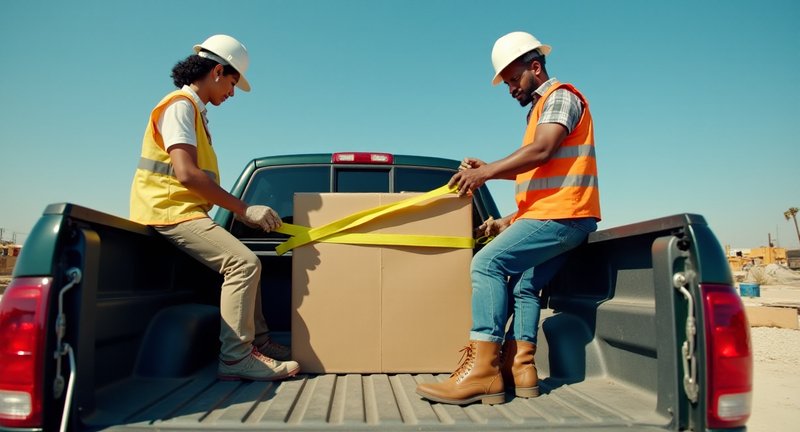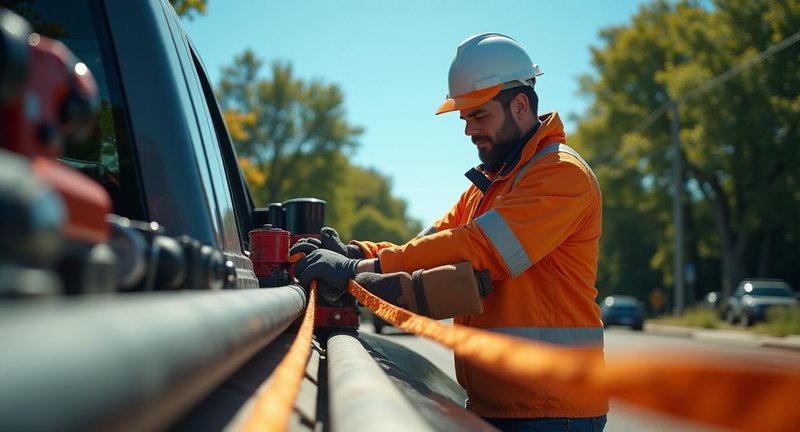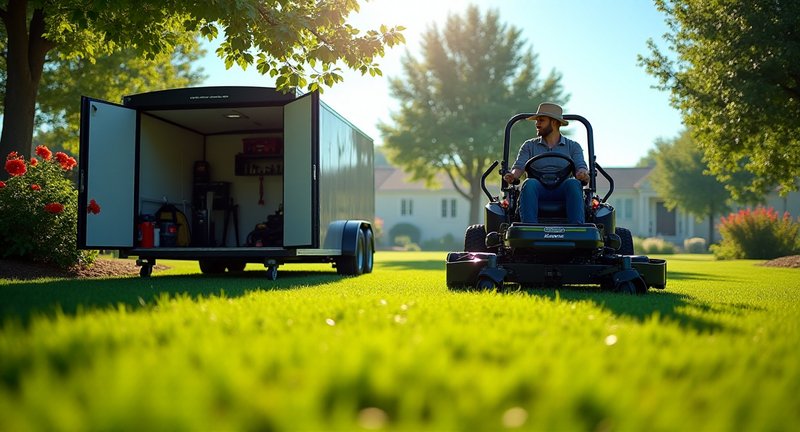An Introductory Look at Vehicle Tie Down Straps
Considering transporting goods or vehicles, ensuring everything is securely fastened is non-negotiable. That’s where Vehicle Tie Down Straps come into play. From my own adventures in hauling everything from ATVs to furniture, I can’t stress enough the peace of mind these straps provide. They’re not just strips of fabric; they’re a crucial lifeline for your cargo.

Let’s break down the essentials of these handy tools:
-
Strength Matters: The tensile strength of your tie down straps is key. Look for straps that can handle the weight of your load without batting an eyelash. Most high-quality straps can bear loads ranging from 1,500 to 5,000 pounds.
-
Length and Width: Consider what you’re securing. Straps come in various lengths (usually between 1 to 30 feet) and widths (from 1 inch to 3 inches). Choose longer and wider straps for bulkier items.
-
Types of Hooks: The type of hook attached to the straps is worth noting. Common options include S-hooks, flat hooks, and J-hooks. Each has its advantages, depending on the anchoring points available in your vehicle.
-
Easy to Use: Look for straps that come with simple ratchet mechanisms or cam buckles. I’ve had my share of wrestling with tangled cords, so ease of use is a real game-changer!
-
Weather Resistance: If you’re hauling goods in various weather conditions, opt for straps with UV protection and water resistance. Trust me; you don’t want to see your straps deteriorate after a single rainy trip.
Moreover, Cargo securing straps are an indispensable part of safe hauling. They ensure that what you’re transporting stays put, so you can focus on the journey ahead instead of worrying about what’s behind you.
The Importance of Vehicle Tie Down Straps
Concerning transporting anything, the peace of mind that comes from securing your load is invaluable. Picture this: you’re on the road, and the last thing you want is for your cargo to be dancing around in the back, right?
I’ve learned through countless trips that having robust straps is like having a trusty sidekick. They keep everything in place, allowing you to focus on the adventure ahead, rather than worrying about what’s rattling in your truck bed.
These straps are not just about securing; they’re about safeguarding your gear from the elements and the bumps of the road. It’s like wrapping a cozy blanket around your belongings, ensuring they arrive in pristine condition.

I remember a time when I was transporting a vintage motorcycle. I meticulously checked every strap, double-checking knots and tightness. That sense of security made the journey so much more enjoyable; I could revel in the scenery rather than stress about the precious cargo bouncing around.
Don’t underestimate the importance of these handy tools. They come in various styles, each designed for different jobs. It’s like having a toolbox; each tool has its unique purpose, helping you achieve that perfect, snug fit.
In my experience, investing in high-quality straps pays off in the long run. They withstand the test of time and ensure that no adventure is marred by an unexpected mishap. Trust me, whether you’re hauling gear for a weekend camping trip or transporting a beloved classic, having the right equipment is crucial.
Understanding Vehicle Tie Down Systems
When dealing with transporting your cherished vehicles, understanding the right systems for securing them is crucial. In my experience, there’s a world of options out there, and navigating them can feel a bit overwhelming. Here are some insights I’ve gathered along the way that might help you make sense of this important aspect of vehicle transportation.
Key Components of Vehicle Securing Systems
-
Straps vs. Chains:
- Straps: These are typically made of heavy-duty fabric and offer flexibility and ease of use. They’re ideal for lighter loads or vehicles with sensitive finishes.
- Chains: Robust and incredibly strong, chains are perfect for heavier or bulkier items. However, they require more effort to set up and can scratch surfaces.
-
Anchoring Points:
- Always ensure you have solid anchoring points on your vehicle and trailer. Whether it’s hooks, D-rings, or built-in latches, these should be strategically placed to distribute the load evenly.
-
Load Distribution:
- The key to a safe transport is balancing the weight. This not only keeps your vehicle secure but also prevents swaying during transit. Think of it like making a well-balanced meal every element matters!
-
Adjustability:
- Look for systems that allow for adjustability. This means you can secure your vehicle snugly, accommodating various shapes and sizes.
-
User-Friendliness:
- I can’t stress enough how important it is to choose a system that’s easy to use. When you’re on the road, the last thing you want is a complicated setup.
By keeping these points in mind, you can confidently secure your vehicle for any adventure, ensuring peace of mind along the journey. Remember, a little preparation goes a long way in protecting your investment!
Importance of Secure Cargo Transportation
With regard to hobbies that involve transporting cargo be it a weekend camping trip or moving your beloved kayaks the importance of secure transportation cannot be overstated. From my own escapades, I’ve learned that safeguarding your load is not just about keeping it intact; it’s about peace of mind during your travels. Let’s dive into why this is crucial.
Benefits of Secure Cargo Transportation:
-
Safety First: Properly securing your gear minimizes the risk of it shifting or, worse, flying off while you’re on the road. Imagine the chaos of your canoe bouncing along the highway yikes!
-
Protection Against Damage: A snug load doesn’t just stay in place; it’s less likely to get scratched, dented, or damaged by the elements. When I first started transporting my mountain bike, I learned this lesson the hard way.
-
Enhanced Fuel Efficiency: Believe it or not, a well-secured load can actually improve your vehicle’s fuel efficiency. When cargo is balanced and secure, your car doesn’t have to work as hard, leading to smoother sailing.
-
Legal Compliance: Depending on where you live, there may be regulations regarding the secure transport of certain items. Nobody wants to deal with a fine while trying to enjoy a hobby!
-
Stress Reduction: As a matter of fact, knowing your cargo is secure allows you to focus on the journey, not the ‘what-ifs.’ Trust me, there’s nothing like cruising down the highway with your gear locked in place, leaving you free to enjoy the scenery.
So, whether you’re a novice or a seasoned pro, investing in the right equipment for securing your cargo is a game changer. It transforms transportation from a potential disaster into a seamless extension of your adventurous spirit.
Types of Straps for Vehicle Load Security
Regarding securing loads in vehicles, the variety of straps available can feel like a treasure trove. Each type offers unique benefits, making it essential to choose wisely based on the task at hand.
In my own adventures, I’ve come across ratchet straps that really pack a punch. They tighten with a satisfying click, ensuring that nothing goes astray, no matter how bumpy the road gets. The beauty of these straps lies in their adjustable nature, allowing me to customize the tension to my heart’s content.
Then, there are cam buckle straps, which are like the friendly neighbor of the strap family. Easy to use, they don’t require much muscle to secure your cargo. Simply feed the strap through the buckle, pull it tight, and voila! Your load is held securely, ready to hit the highway.
Let’s not forget the classic flatbed straps. These sturdy heroes come equipped with D-rings, which provide a solid anchor point for your cargo. I love how they distribute weight evenly, giving me peace of mind while driving.
For those larger or bulkier items, heavy-duty webbing is your best friend. This type of strap boasts impressive strength and durability. When I’ve had to haul oversized loads, these straps have never let me down.
As a matter of fact, if you’re looking for versatility, consider adjustable straps. They adapt to various shapes and sizes, making them perfect for any unexpected load. With these handy tools, I always feel prepared for the road ahead.
Choosing the right strap can transform your hauling experience from a stressful chore to a smooth journey. Trust me; it’s worth investing the time to find the right fit for your needs!
Materials Used in Cargo Straps
Considering securing cargo, the materials used in straps can make all the difference. From my adventures hauling everything from furniture to outdoor gear, I’ve learned that not all straps are created equal. Here’s a breakdown of common materials that elevate the performance of these unsung heroes of transportation.
1. Polyester
This sturdy synthetic fiber is a champion in the strap world. It boasts remarkable strength and excellent UV resistance, making it perfect for outdoor use. I’ve often relied on polyester straps for their durability and ability to withstand the elements without fraying.
2. Nylon
Ah, the classic! Nylon is another synthetic favorite known for its stretchiness. While it may not hold up against UV rays like polyester, its impressive tensile strength is a game changer. I’ve found nylon straps particularly useful in situations where a bit of give is beneficial, like securing soft cargo that needs to stay snug without damage.
3. Webbing
Let’s not forget about webbing this material is the backbone of many cargo straps. Typically woven from polyester or nylon, it provides the necessary stability and strength. A well-constructed webbing can distribute weight evenly, ensuring that whatever you’re transporting stays put.
4. Metal Hooks and Buckles
The connectors are just as crucial as the straps themselves. Whether you opt for steel or aluminum, strong hooks and buckles ensure a secure grip. I can’t tell you how many times I’ve felt more confident knowing I had quality hardware holding everything in place.
5. Reinforced Stitching
As a matter of fact, let’s chat about stitching. A strap with reinforced seams is a worthy investment. It not only boosts durability but also adds to the overall safety of your load.
In my experience, choosing the right materials transforms cargo security from a mere task into an art form one that keeps your belongings safe and sound as you hit the road.
Choosing the Right Length for Your Needs
Regarding securing your vehicle or cargo, one of the most important decisions you’ll make is choosing the right length for your Vehicle Tie Down Straps. Trust me, this can make all the difference between a smooth ride and a chaotic mess. I’ve had my share of experiences, and here are a few things I’ve learned along the way.
Consider Your Needs:
-
Type of Vehicle:
- Pickup trucks, SUVs, or compact cars? The type of vehicle you’re securing will influence the length you need. Longer straps might be necessary for larger vehicles.
-
Cargo Dimensions:
- Are you hauling a boat, motorcycle, or lumber? Understanding the dimensions of your cargo is crucial. For larger items, you might need longer straps to accommodate various tie-down points.
-
Anchor Points:
- Where will you attach the straps? Knowing the location of your vehicle’s anchor points can help you decide how long your straps should be.
Length Recommendations:
- Short Straps (1-2 feet): Ideal for smaller items or if you need to make quick adjustments.
- Medium Straps (3-5 feet): Great for securing average-sized loads and providing some flexibility.
- Long Straps (6+ feet): Perfect for larger vehicles or oversized cargo; these offer the most versatility but can be trickier to manage.
Also, it’s about balancing functionality with ease of use. I’ve found that a longer strap might seem like a hassle at first, but they often give you more options when it comes to securing loads effectively. Don’t forget: a well-secured load isn’t just safer for you, but for everyone else on the road as well!
Weight Capacity Considerations
As for hauling equipment or gear, understanding weight capacity is like knowing the rules of the road before you hit the highway. In my many adventures of loading up for camping trips or transporting kayaks, I’ve learned that respecting the limits is paramount for safety and efficiency.
Here are some key considerations when assessing weight capacity for your gear:
-
Manufacturer Guidelines: Always check the specifications provided by the manufacturer. They usually have clear guidelines indicating the maximum load capacity.
-
Material Strength: Different materials can support varying weights. For instance, heavy-duty nylon or polyester materials are often more reliable than their lighter counterparts.
-
Distribution of Weight: Properly distributing weight can dramatically affect stability. Aim for a balanced load to avoid swaying during transit, which could lead to mishaps.
-
Environmental Factors: Remember that weather conditions can impact how secure your load is. For example, wet conditions can make straps less effective, so be cautious.
-
Inspection Before Use: I always perform a pre-journey inspection of all securing equipment. A quick check can save a whole lot of trouble down the line.
Speaking from experience, overloading or improperly securing your gear can lead to unforeseen issues. It’s a reminder to be cautious, especially when venturing out with precious cargo. There’s nothing worse than having to pull over halfway through a journey to fix a mess that could have been avoided.
Remember, safety should always take precedence, so gear up wisely!
Ratchet vs. Cam Buckle Straps: What’s Best?
When dealing with securing cargo, choosing between ratchet straps and cam buckle straps feels a bit like deciding between a trusty old dog and a flashy new gadget. Both have their merits, but I find myself leaning toward ratchet straps for their tenacious grip.
Ratchet straps resemble a wrestling champion, clamping down tight with a satisfying click. They offer a remarkable amount of tension control, making them perfect for heavy loads. There’s a certain satisfaction in the way they ratchet down, locking in your cargo as if it were tucked into a snug blanket.
On the other hand, cam buckle straps are like a gentle hug easy to use and forgiving. I often reach for these when I need to secure lighter loads or when I’m in a hurry. You simply pull the webbing through the buckle and, voila! Your items are held firmly, yet there’s no wrestling match required.
I’ve found that for quick tasks, cam buckle straps shine. They allow for a swift setup without the fuss of tightening and adjusting. However, when I’m gearing up for a cross-country adventure, ratchet straps become my trusty sidekick.
In the end, the choice boils down to what you’re securing. If it’s heavy-duty and demanding, ratchet straps will embrace the challenge. But for lighter loads, cam buckle straps are a breeze, making them my go-to for spontaneous trips. So, whether you prefer the brute strength of ratchet straps or the ease of cam buckle straps, the best option is the one that fits your cargo needs.
A Detailed Look at Vehicle Tie Down Straps
As for transporting precious cargo be it a vintage motorcycle, a shiny new car, or a load of equipment having the right gear is paramount. After several trips filled with anticipation and the occasional heart-stopping moment, I’ve learned the true value of those trusty straps that keep everything securely in place. Let me share some insights from my adventures.
Key Features to Consider:
-
Material Quality: Look for heavy-duty materials like polyester that resist wear and tear. You want these to hold up against the elements and the rigors of the road.
-
Width and Length: A wider strap distributes weight better, reducing the risk of damage to your vehicle. Similarly, longer lengths provide versatility for different tie-down points.
-
Breaking Strength: This is not just a number; it’s your safety net! Aim for straps with a high breaking strength to ensure they can withstand the forces during transport.
-
Hook Types: From S-hooks to J-hooks, the type of hooks matters. I’ve found that ratchet hooks offer a solid grip and are less likely to come undone during travel.
-
Ease of Use: After a long day, the last thing you want is a complicated setup. Look for features like quick-release buckles or color-coded straps for effortless handling.
From my experience, the best approach is to practice your loading technique. Give yourself a test run at home just like a rehearsal before a big performance. You’ll gain confidence and refine your methods, ensuring your cargo reaches its destination unscathed.

So, next time you hit the road, remember that these simple yet powerful tools can make all the difference in keeping your cargo safe and sound.
Understanding Strap Width and Its Impact
Considering securing items for transport, strap width plays a crucial role that often flies under the radar. From my own adventures in hauling gear, I’ve discovered that the width of a strap can drastically influence both the stability of your load and the ease of handling.
Imagine a strap that feels like a delicate ribbon versus one that resembles a sturdy belt. The difference is palpable. A wider strap distributes weight more evenly, reducing the chances of damaging your precious cargo while providing a solid grip that inspires confidence.
In my experience, using straps that are too narrow can lead to a precarious situation. Picture this: you’re cruising down the highway, and that slim strap begins to dig into your load. The potential for slippage increases, and suddenly, your heart races with concern. Opting for a wider strap can be a game-changer, transforming that anxiety into peace of mind.
Let’s not forget about the practical aspect, either. Wider straps often come equipped with more robust fittings. This means less time fussing with adjustments and more time enjoying your journey. It’s all about efficiency, right?
I’ve learned that the right strap width isn’t just a detail; it’s an essential ingredient in the recipe for a successful haul. So, next time you’re gearing up for a transport task, give some thought to strap width. It could very well be the difference between a smooth ride and a nail-biting experience.
Weather Resistance and Durability Features
When dealing with transporting gear, the last thing you want is to face the wrath of Mother Nature. I’ve had my share of wet adventures where the elements threaten to ruin my carefully packed treasures. That’s why I pay close attention to weather resistance and durability features in my gear.
Imagine this: you’re cruising down a rain-soaked highway, and your equipment remains snug and dry. High-quality materials, like weather-resistant fabrics and sturdy buckles, create a protective cocoon against the elements. I’ve learned that investing in gear designed to withstand the elements is not just a luxury; it’s a necessity.
The craftsmanship of the straps also plays a crucial role. Reinforced stitching and corrosion-resistant hardware can make all the difference in maintaining the integrity of your gear over time. After countless trips, I can assure you that durability isn’t just about the initial investment it’s about the longevity of your gear.
A little extra attention to detail goes a long way. Features like UV resistance help prevent fading and degradation from sunlight exposure. I can’t tell you how many times I’ve appreciated this on sunny days when I’d otherwise be worrying about wear and tear.
So, when you’re on the hunt for securing equipment, keep an eye out for weather-resistant options. In my experience, they offer peace of mind on any adventure, letting you focus on the journey ahead instead of the state of your gear.
Ease of Use: Quick Release and Adjustment
As for securing items for transport, I’ve found that the ease of use can make all the difference. Quick release mechanisms and easy adjustments can turn a daunting task into a walk in the park. Let me share some insights based on my experiences!
Imagine this: you’re loading your gear, and you want everything snug and secure. That’s where the magic of user-friendly designs comes in. Here’s what I love about these handy tools:
-
Quick Release: No more fumbling around with complicated knots or intricate mechanisms. A simple pull of a lever or a press of a button releases everything in a flash. Trust me, in moments of urgency, this feature feels like a superhero swooping in to save the day!
-
Adjustable Lengths: You don’t want to be stuck with a one-size-fits-all solution. I appreciate systems that let you adjust the length with minimal effort. Whether you’re hauling a surfboard or a pile of firewood, the ability to customize the fit ensures everything stays put without being too tight or too loose.
-
Tangle-Free Design: Let’s be real nobody enjoys wrestling with a ball of straps. Many modern options come with a design that prevents tangling, making setup and takedown a breeze. Just grab, extend, and secure. Easy peasy!
-
Sturdy Materials: While ease of use is crucial, durability is key. I look for materials that can withstand the elements and the test of time, ensuring my equipment stays safe regardless of the journey.
In my experience, investing in these user-friendly systems has transformed the way I approach transporting my gear. So, next time you’re preparing for an adventure, consider how quick release and adjustable features can enhance your overall experience.
Safety Ratings and Compliance Standards
In the context of securing our beloved toys whether it’s that snazzy jet ski or your trusty all-terrain vehicle safety ratings and compliance standards play a vital role. Trust me, nothing kills the thrill of adventure faster than the worry of your gear bouncing down the road.
First off, understanding compliance standards is key. They’re like the guardrails on a winding mountain road, ensuring that what you’re using meets certain safety benchmarks. A piece of gear that flaunts a high safety rating is not just a shiny badge; it’s a promise that it’s been rigorously tested to handle the bumps and jolts of the journey ahead.
I remember the first time I loaded my mountain bike for a weekend trip. I thought I could just wing it with some generic straps, but after a few minutes of research, I realized that not all gear is created equal. I ended up choosing straps that not only looked durable but also had stellar ratings, and let me tell you, that made all the difference.
Imagine cruising down the highway, wind in your hair, knowing that your precious cargo is snug as a bug. The peace of mind that comes from adhering to safety standards is priceless. It’s like having a safety net beneath you, allowing you to focus on the thrill of the ride instead of fretting over potential mishaps.
So, as you gear up for your next adventure, take a moment to check those safety ratings. You wouldn’t want to compromise on your journey just for the sake of a bargain. After all, safety and adventure go hand in hand, and I’d rather be safe than sorry!
Common Applications for Cargo Straps
When I think about cargo straps, I often reflect on their versatility in everyday life. These nifty little tools aren’t just for securing loads; they’re your silent partners in a myriad of tasks. Let me share some common applications that might just inspire you to incorporate them into your next project.
-
Moving Furniture: If you’ve ever tried moving a heavy sofa, you know the struggle! Using cargo straps can significantly ease the burden. You can wrap the straps around the item and your helper can lift without worrying about dropping it or losing grip.
-
Camping Gear: On my adventures into the great outdoors, I find these straps are lifesavers for securing tents, coolers, and other gear to my vehicle’s roof rack. They keep everything in place, allowing me to focus on enjoying nature rather than worrying about my gear.
-
Bicycle Transport: When I’m loading my bike for a weekend ride, I rely on cargo straps to keep it secure on the rack. A little extra stability means I can hit the road with confidence, knowing my trusty steed is safe.
-
Home Organization: Cargo straps can also be a great solution for organizing your garage or shed. I often use them to bundle tools or hold boxes together, transforming chaos into a neat little system.
-
Construction Projects: Whether it’s lumber or heavy equipment, I’ve found that cargo straps provide the necessary support to ensure nothing shifts unexpectedly. They can easily adapt to different sizes and weights, making them a go-to in construction.
So, next time you find yourself in need of securing or organizing, consider cargo straps as your unsung hero. They’re more than just a tool; they’re a reliable companion in tackling life’s little challenges.
Answer Hub
Can you use straps to tie-down a car?
Yes, you can use straps to tie down a car safely and securely during transportation. Tie-down straps are specifically designed to hold vehicles in place, preventing movement during transit. It’s essential to use high-quality, durable straps rated for the weight of the car. Axle straps or wheel straps can be attached to the vehicle’s chassis or tires. Ensure that the straps are tightened properly to avoid slack, as this could lead to shifting or even damage to the vehicle.
Why do truckers twist straps?
Truckers twist straps to prevent them from loosening during transit. Twisting the strap helps to create friction, reducing the chance of slippage as the vehicle moves. Additionally, twisted straps can minimize wind resistance and noise, which is particularly beneficial when traveling long distances. This practice is part of proper load securement techniques, ensuring that cargo remains stable and safe while on the road. Also, it enhances the overall security of the load and protects both the vehicle and the cargo.
How do you tie-down a car with axle straps?
To tie down a car using axle straps, first, position the vehicle on a flat surface. Begin by placing the axle straps around the vehicle’s axles or under the tires, ensuring a snug fit. Next, attach the ends of the straps to the tie-down points on the trailer or flatbed. Use a ratchet or cam buckle to tighten the straps securely. Be careful to avoid excessive pressure that could damage the vehicle’s components. After tightening, double-check that the straps are secure and that the car cannot move.
How do you tie-down a truck with ratchet straps?
To tie down a truck using ratchet straps, start by parking the truck on a level surface. Place the ratchet straps around the truck’s frame or designated tie-down points, ensuring they are positioned correctly. Thread the strap through the ratchet mechanism and pull to create tension. Ratchet the strap until it is secure but not overly tight, as excessive pressure can cause damage. As a matter of fact, check the tightness of the straps to confirm that the truck is secured and will not shift during transportation.
How many straps to secure a car?
The number of straps needed to secure a car can vary based on the vehicle’s size and weight, as well as the type of transport. Generally, it is recommended to use at least four tie-down straps two for the front and two for the rear to ensure even weight distribution and stability. Larger or heavier vehicles may require additional straps for optimal security. Always consult industry regulations and best practices to determine the appropriate number of straps for specific transport situations.
What are the requirements for tie down straps?
Tie-down straps must meet specific requirements to ensure safety and effectiveness during transportation. They should be made of high-strength materials, such as polyester, capable of handling the load’s weight. Straps must have appropriate working load limits (WLL) and breaking strength ratings clearly indicated. Additionally, straps should be free from any frays, cuts, or defects that could compromise their integrity. Proper fittings and securement methods, such as ratchets or cam buckles, are also essential to maintain tension and prevent slippage during transit.
Why do truckers sleep with their trucks on?
Truckers often sleep with their trucks on to maintain comfort and security. Leaving the engine running provides heating or cooling, depending on the weather, which can be crucial for a good night’s rest. Additionally, having the truck running can keep essential systems, like refrigeration for cargo, operational. It also ensures that the truck remains secure; if someone tries to tamper with the vehicle, the driver can respond quickly. However, truckers must balance this with fuel consumption and noise considerations in rest areas.
Does twisting a strap weaken it?
Twisting a strap does not significantly weaken it if done correctly; in fact, it can enhance its performance during transportation. Twisting creates friction that helps prevent the strap from loosening over time, thereby maintaining the tension required to secure the load. However, it is essential to avoid excessive twisting, which could cause kinks or damage to the fibers, potentially compromising the strap’s integrity. Always ensure that straps are inspected regularly for any signs of wear or damage to maintain safety during transport.
Why do truckers stop on the side of the road?
Truckers may stop on the side of the road for several reasons, including fatigue, vehicle issues, or to take a break. The long hours of driving can lead to tiredness, making it essential for drivers to rest to maintain safety. Additionally, if a truck experiences mechanical problems, stopping may be necessary to assess and address the situation. Truckers also utilize these stops for meals, restroom breaks, or to stretch and move around, which is vital for their overall well-being during long hauls.











Your thoughts on strap width really hit home! I remember a trip where I learned this lesson the hard way. Using a narrow strap made me feel like I was walking a tightrope, always worried that it would slip. Switching to a wider strap transformed my hauling experience! It’s like the difference between a flimsy ribbon and a solid belt, as you beautifully put it. Wider straps not only distribute weight evenly but also give that reassuring grip that keeps your mind at ease while on the road. Plus, you nailed it with the practical aspect those robust fittings save so much time, allowing me to focus on enjoying the journey rather than fumbling with adjustments. Strap width is indeed a game-changer, and I appreciate you highlighting its importance!
I absolutely resonate with your experience on the importance of having the right gear for transporting precious cargo! Those heart-stopping moments you mentioned are all too familiar. I’ve had my fair share of close calls, especially with securing my vintage motorcycle. Your emphasis on material quality really strikes a chord; I always opt for heavy-duty polyester straps because they truly hold up against the elements. And let’s not forget about breaking strength there’s no feeling quite like knowing your gear is secure thanks to a reliable strap! Practicing loading techniques at home is a fantastic tip! It’s like preparing for a performance, and it definitely boosts confidence. Thanks for sharing these insights; they’re sure to help anyone looking to transport their beloved gear safely!
I love the analogy between ratchet straps and cam buckle straps! It’s so relatable! I’ve had my fair share of struggles with both types, but I totally agree that ratchet straps are like a trusty sidekick for heavy loads. That satisfying click when they lock in is music to my ears! On a recent road trip, I used them for my motorcycle, and it felt like I was wrapping it in a protective hug. However, for lighter items, cam buckle straps have become my go-to, especially when I’m in a hurry. Their simplicity makes everything easier, doesn’t it? It’s all about knowing when to use which type. Ultimately, it’s about making our journeys as smooth as possible, and your insights help make those decisions easier. Cheers to secure adventures ahead!
Ah, the weight capacity! Such an important topic that often gets overlooked. I’ve definitely learned the hard way about the significance of manufacturer guidelines. On one camping trip, I went all-in with my gear and exceeded the weight limit, only to find out my straps were struggling. Talk about a bumpy ride! Distributing weight properly is also a game changer. I’ve started organizing my gear to ensure everything stays balanced, and it’s made a world of difference in stability. And yes, environmental factors can’t be ignored! A quick pre-journey inspection is now my ritual. It feels great knowing that I’ve taken those extra steps to keep my cargo safe. Thanks for the reminder!
Choosing the right length for Vehicle Tie Down Straps is indeed crucial! I remember when I first started hauling larger items, I thought I could get away with shorter straps, but I quickly learned my lesson. It’s like trying to fit a square peg in a round hole! You’re spot on about considering the type of vehicle and cargo dimensions. I also discovered that having longer straps gives me the flexibility to adjust as needed. And I love how you highlighted the importance of anchor points! They truly make a difference. A well-secured load not only protects my stuff but keeps everyone safe on the road. Great insights here!
What a fantastic overview of strap materials! I never realized how much the choice of material could impact performance. Polyester has become my favorite for outdoor trips no fraying after a few rough rides! I also love how you highlighted the importance of reinforced stitching. It’s such a small detail that makes a huge difference in durability. I totally agree that investing in quality materials turns cargo securing into an art! Thanks for the great tips!
I really appreciate your breakdown of the various types of straps! It’s like having a toolbox for every scenario. Ratchet straps are a personal favorite of mine, too; there’s something satisfying about that click! I often find myself experimenting with different straps for various trips, and it’s true: the right one can make all the difference. The cam buckle straps are my go-to for quick setups, especially when I’m in a hurry. And the versatility of adjustable straps has saved me on countless occasions! The last trip I took, I had a last-minute bulky load, and those adjustable straps were a lifesaver. It’s amazing how something so simple can enhance our experiences. Your advice on choosing the right strap really hits home!
I completely agree with your emphasis on secure cargo transportation! I’ve had my share of chaotic experiences when my kayak decided to take a leap off the roof. It’s so true that peace of mind is crucial. The benefits you listed are spot on especially the stress reduction. Nothing beats the feeling of hitting the open road, knowing that everything is secured and I can focus on enjoying the adventure ahead. Thanks for sharing your insights!
Navigating the world of vehicle securing systems can feel like solving a puzzle! I’ve tried both straps and chains, and each has its pros and cons. While I love how flexible straps can be, chains offer that extra brute strength for heavier loads. It’s all about finding what suits your needs best! Anchoring points are crucial too; I remember a time when I thought I could get away without checking mine and, boy, did that teach me a lesson! Balancing the load is just like preparing a meal; if one ingredient is off, the whole dish can fall apart. Adjustability is a fantastic feature that I always look for, as it accommodates different vehicle shapes effortlessly. And let’s not forget user-friendliness; a complicated setup is the last thing you want when you’re itching to hit the road! Taking the time to prepare not only protects your investment but also enhances the entire transport experience. Thanks for sharing these insights; they’ve certainly reminded me of some c
Your description of the peace of mind that comes with properly securing a load is spot on! I had my share of “cargo dances” in the back, and let me tell you, it’s not fun to witness while driving! I once transported a set of antique furniture, and those straps felt like my safety net, preventing any mishaps. It’s funny how a good set of straps can feel like having a superhero on your side, isn’t it? Investing in quality materials has saved me countless headaches, and I wholeheartedly agree that the right gear is essential for any adventure. Whether it’s a camping trip or just a day out, a snug fit gives you the freedom to enjoy the journey without constantly glancing back to check on the cargo.
I couldn’t agree more about the importance of Vehicle Tie Down Straps! After years of transporting everything from motorcycles to furniture, I’ve learned the hard way that quality straps are worth their weight in gold. Those stats on tensile strength are crucial; I always go for the ones that can handle at least 3,000 pounds because, let’s be honest, you never know when you might push the limits! I also appreciate the variety of lengths and widths available, especially for securing different types of loads. And don’t get me started on the ease of use; my first experience with a ratchet strap was a game changer! These little things make a huge difference, ensuring everything stays put.